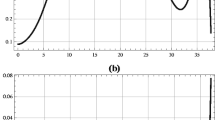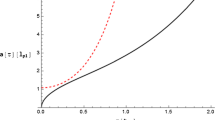Abstract
In the present work, we study the quantum cosmology description of two Friedmann-Robertson-Walker models in the presence of a stiff matter perfect fluid and a negative cosmological constant. The models differ from each other by the constant curvature of the spatial sections, taken to be either positive or zero. We work in the Schutz’s variational formalism, quantizing the models and obtaining the appropriate Wheeler-DeWitt equations. In these models there are bound states. Therefore, we compute, for each one, the discrete energy spectrum and the corresponding eigenfunctions. After that, we use the eigenfunctions in order to construct wave packets and evaluate the time-dependent expectation values of the scale factors. Each model shows bounded oscillations for the expectation value of the scalar factor, which is never zero, which can be interpreted as an initial indication that these models may not have singularities at the quantum level.






Similar content being viewed by others
References
Zeldovich, Y.B.: Zh. Eksp. Teor. Fiz. 41, 1609 (1961)
Zeldovich, Y.B.: Sov. Phys. JETP 14, 1143 (1962)
Colistete, R. Jr., Fabris, J.C., Pinto-Neto, N.: Phys. Rev. D 57, 4707 (1998)
Colistete, R. Jr., Fabris, J.C., Pinto-Neto, N.: Phys. Rev. D 62, 083507 (2000)
Falciano, F.T., Pinto-Neto, N., Santini, E.S.: Phys. Rev. D 76, 083521 (2007)
Oliveira-Neto, G., Monerat, G.A., Corrêa Silva, E.V., Neves, C., Ferreira Filho, L.G.: Int. J. Mod. Phys. Conf. Ser. 3, 254 (2011)
Kamionkowski, M., Turner, M.S.: Phys. Rev. D 42, 3310 (1990)
Joyce, M.: Phys. Rev. D 55, 1875 (1997)
Salati, P.: Phys. Lett. B 571, 121 (2003)
Pallis, C.: Nucl. Phys. B 751, 129 (2006)
Gomez, M.E., Lola, S., Pallis, C., Rodriguez-Quintero, J.: J. Cosmol. Astropart. Phys. 01, 027 (2009)
Pallis, C.: Nucl. Phys. B 831, 217 (2010)
Zeldovich, Y.B.: Mon. Not. R. Astron. Soc. 160, 1 (1972)
Joyce, M., Prokopec, T.: Phys. Rev. D 57, 6022 (1998)
Sahni, V., Sami, M., Souradeep, T.: Phys. Rev. D 65, 023518 (2001)
Alvarenga, F.G., Fabris, J.C., Lemos, N.A., Monerat, G.A.: Gen. Relativ. Gravit. 34, 651 (2002)
Green, M.B., Schwarz, J.H., Witten, E.: Superstring Theory, vol. 1. Cambridge University Press, Cambridge (1987)
Green, M.B., Schwarz, J.H., Witten, E.: Superstring Theory, vol. 2. Cambridge University Press, Cambridge (1987)
Maldacena, J.: Adv. Theor. Math. Phys. 2, 231 (1998)
Carlip, S.: Phys. Rev. Lett. 79, 4071 (1997)
Anderson, M., Carlip, S., Ratcliffe, J.G., Surya, S., Tschantz, S.T.: Class. Quantum Gravity 21, 729 (2004)
Oliveira-Neto, G.: Phys. Rev. D 58, 10750 (1998)
Monerat, G.A., Corrêa Silva, E.V., Oliveira-Neto, G., Ferreira Filho, L.G., Lemos, N.A.: Phys. Rev. D 73, 044022 (2006)
Schutz, B.F.: Phys. Rev. D 2, 2762 (1970)
Schutz, B.F.: Phys. Rev. D 4, 3559 (1971)
Dirac, P.A.M.: Can. J. Math. 2, 129 (1950)
Dirac, P.A.M.: Proc. R. Soc. Lond. Ser. A, Math. Phys. Sci. 249, 326 (1958)
Dirac, P.A.M.: Proc. R. Soc. Lond. Ser. A, Math. Phys. Sci. 249, 333 (1958)
Dirac, P.A.M.: Phys. Rev. 114, 924 (1959)
Lemos, N.A.: J. Math. Phys. 37, 1449 (1996)
Acacio de Barros, J., Corrêa Silva, E.V., Monerat, G.A., Oliveira-Neto, G., Ferreira Filho, L.G., Romildo, P. Jr.: Phys. Rev. D 75, 104004 (2007)
Monerat, G.A., Oliveira-Neto, G., Corrêa Silva, E.V., Ferreira Filho, L.G., Romildo, P. Jr., Fabris, J.C., Fracalossi, R., Gonçalves, S.V.B., Alvarenga, F.G.: Phys. Rev. D 76, 024017 (2007)
Boyd, J.P.: Chebyshev and Fourier Spectral Methods, 2nd edn. Dover, New York (2001)
Pedram, P., Mirzaei, M., Gousheh, S.S.: Comput. Phys. Commun. 176, 581 (2007)
Pedram, P., Mirzaei, M., Jalalzadeh, S., Gousheh, S.S.: Gen. Relativ. Gravit. 40, 1663 (2008)
Bonazzola, S., Gourgoulhon, E., Marck, J.A.: J. Comput. Appl. Math. 109, 433–473 (1999)
Kidder, L.E., Finn, L.S.: Phys. Rev. D 62, 084026 (2000)
Kidder, L.E., Scheel, M.A., Teukolsky, S.A., Carlson, E.D., Cook, G.B.: Phys. Rev. D 62, 084032 (2000)
Pfeiffer, H.P., Kidder, L.E., Scheel, M.A., Teukolsky, S.A.: Comput. Phys. Commun. 152, 253–273 (2003)
Grandclément, P., Novak, J.: Living Rev. Relativ. 12, lrr-2009-1 (2009)
Oliveira, H.P., Rodrigues, E.L.: Class. Quantum Gravity 28, 235011 (2011)
Pedram, P., Jalalzadeh, S.: Gen. Relativ. Gravit. 42, 745 (2010)
Barboza, E.M. Jr., Lemos, N.A.: Phys. Rev. D 78, 023504 (2008)
Pedram, P., Jalalzadeh, S., Gousheh, S.S.: Class. Quantum Gravity 24, 5515 (2007)
Pedram, P., Jalalzadeh, S., Gousheh, S.S.: Phys. Lett. B 655, 91 (2007)
Barboza, E.M. Jr., Lemos, N.A.: Gen. Relativ. Gravit. 38, 1609 (2006)
Lemos, N.A., Monerat, G.A.: Gen. Relativ. Gravit. 35, 423 (2003)
Acknowledgements
G. Oliveira-Neto thanks Fundação de Amparo à Pesquisa do Estado de Minas Gerais, FAPEMIG, for partial financial support. E.V. Corrêa Silva (Researcher of Conselho Nacional de Desenvolvimento Científico e Tecnológico, CNPq, Brazil), G.A. Monerat, C. Neves and L.G. Ferreira Filho thank CNPq and Fundação Carlos Chagas Filho de Amparo à Pesquisa do Estado do Rio de Janeiro, FAPERJ, for partial financial support. E.V. Corrêa Silva and G.A. Monerat thank Universidade do Estado do Rio de Janeiro, UERJ, for the Prociência grant, via FAPERJ.
Author information
Authors and Affiliations
Corresponding author
Appendix: Checking the Solutions
Appendix: Checking the Solutions
In general, the matricial equation (23) is not satisfied exactly by the eigenvalues and eigenvectors obtained. Actually, one expects that the difference between its r.h.s. and l.h.s. be a vector with small but non-vanishing components. We may use the largest (in absolute values) of those components as a measure of error of our approximate solution. (The same number of digits used in spectrum calculations should be used, of course.) Besides, distinct eigenvalues/eigenvectors may yield distinct errors, as shown in Fig. 7: the horizontal axis correspond to the index of the levels, and the vertical axis represents the logarithm of the corresponding error.
Error in equation, for each eigenvalue. In this figure, we are considering the model with k=0. The horizontal axis shows the eigenvalue indices (1st, 2nd,…,250th), rather than their actual values. The vertical axis shows the decimal logarithm of the absolute value of the error obtained when eigenvalues and eigenvectors are substituted back in the matricial eigenvalue equation. Notice that lower levels are more accurate than upper levels
By limiting the number of levels used in the wave packet, we have kept this error under ≈1.6×10−11.
If N functions are used as basis functions for the wave packet (15), we obtain the N×N matricial equation Eq. (23). We have used N=250 in our paper; if we compare the eigenvalues for that situation to those obtained for, say, N=260, we observe, for the first 250 eigenvalues, the percental variations shown in Fig. 8.
(a) Absolute value of the percental variation in each eigenvalue of the spectrum when calculations are carried out with 250 levels and 260 levels, for the model with k=0; the horizontal axis shows the eigenvalue indices (1st, 2nd,…,250th), rather than their actual values. (b) Zoom on the first 30 levels
Then again, the lower the eigenvalues, the better the convergence. The first 18 levels show variations of less than 1.9 %.
We have also checked the orthogonality of approximate eigenfunctions. The results are shown in Fig. 9. Once more, the lower the eigenvalues, the better the orthogonality. Similar results are obtained when we compare the 2nd, 3rd, etc. levels to the upper levels.
Checking the orthogonality of eigenvectors with respect to the first eigenvector, for the model with k=0. The horizontal axis shows the energy level indices (1st, 2nd, etc.), not their actual values. The vertical axis shows the logarithm of the absolute value of the inner product of eigenvectors (the weight function having been taken into account, naturally). Observe that the lowest levels show better results than the upper ones
Finally, we have also observed the behavior of the norm of the packet. In Fig. 10 the norm as a function of time is shown for wave packets obtained for the equiprobable superposition of the 18 lowest levels, for N=250; for the case k=0, variations in the norm are smaller than 10−12, whereas for k=1 variations in the norm are smaller than 10−11. Similarly, Fig. 11 shows the norm as a function of time is shown for wave packets obtained for the equiprobable superposition of the 25 lowest levels, for N=250; for the case k=0, variations in the norm are smaller than 10−12, whereas for k=1 variations in the norm are smaller than 10−11.
The results of the checkings mentioned above give us good confidence in our results. The choice of the 18 lowest levels was made in order to keep the accuracy of our results within satisfactory values.
Rights and permissions
About this article
Cite this article
Oliveira-Neto, G., Monerat, G.A., Corrêa Silva, E.V. et al. Quantization of Friedmann-Robertson-Walker Spacetimes in the Presence of a Cosmological Constant and Stiff Matter. Int J Theor Phys 52, 2991–3006 (2013). https://doi.org/10.1007/s10773-013-1590-7
Received:
Accepted:
Published:
Issue Date:
DOI: https://doi.org/10.1007/s10773-013-1590-7









